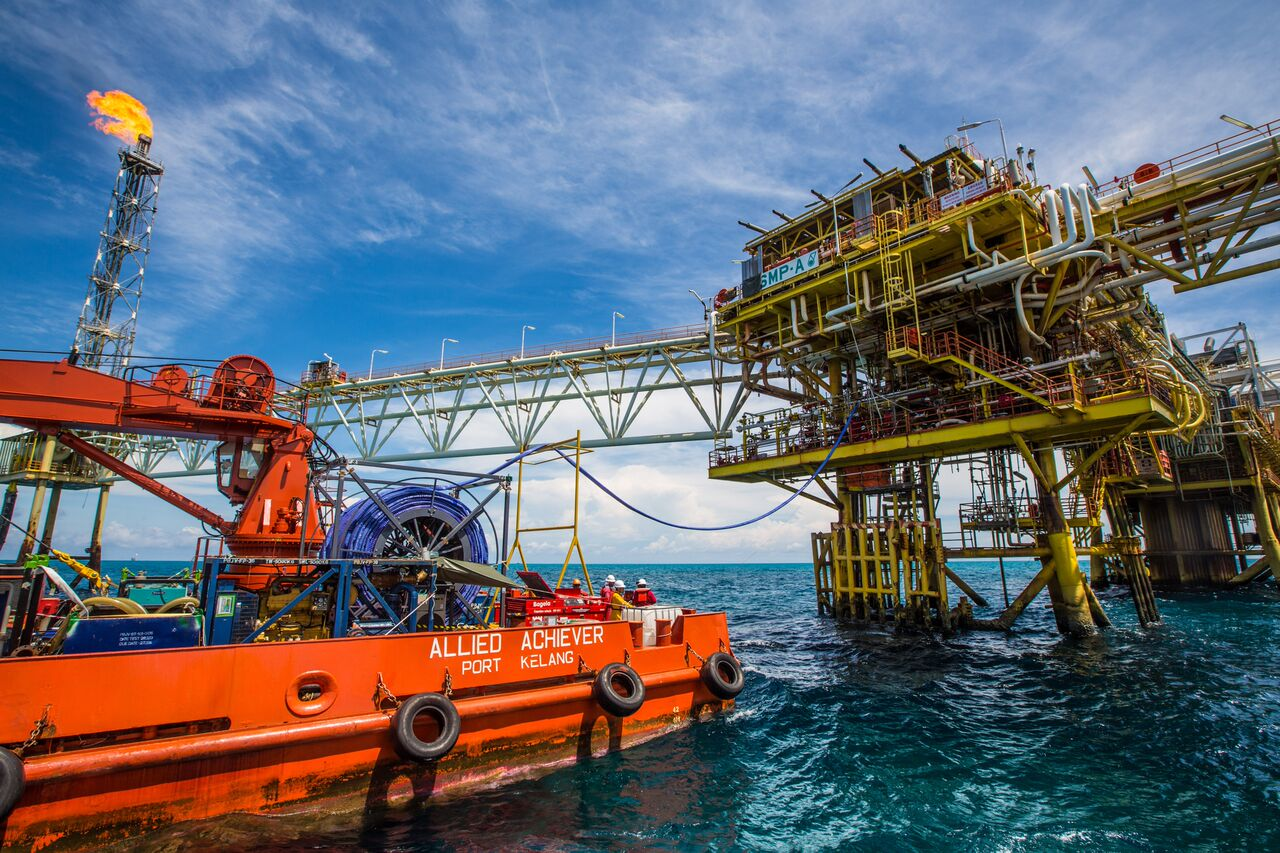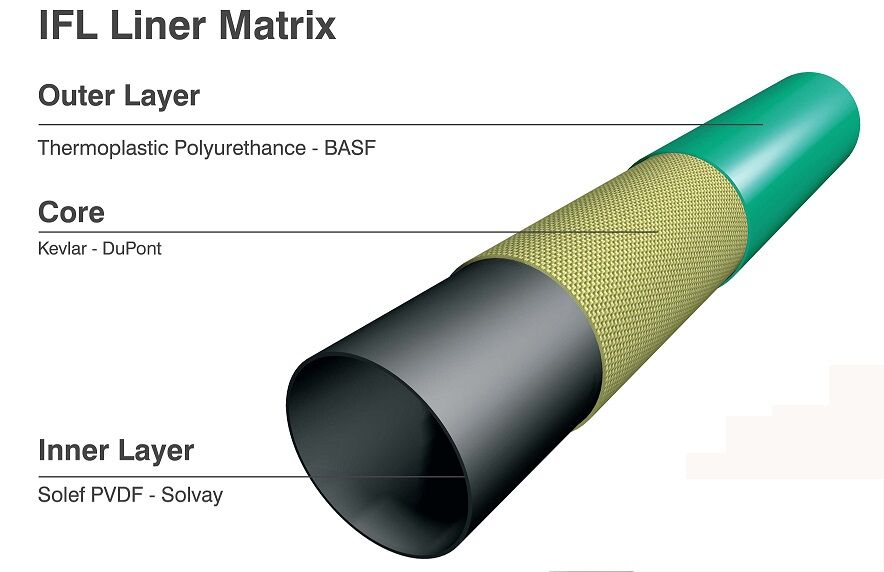During this period of declining oil prices, PETRONAS recognizes the extremely effective cost optimization represented by the ability to rehabilitate near-end-of-life pipelines as opposed to mounting large-scale replacement campaigns.
The InField Liner (IFL) system, developed under the joint management of PETRONAS and Anticorrosion Protective Systems (APS), when installed in existing subsea pipelines acts as a corrosion barrier, providing protection against aggressive service conditions and extending the use of the pipeline far beyond its original design life.
The IFL system was successfully piloted at PETRONAS Carigali Sdn Bhd’s (PCSB) Samarang Field in September, and a commercial trial was deployed at West Lutong Field in November 2014.

 Liner specs
Liner specs
The IFL comprises a polyvinylidene fluoride (PVDF) inner liner from Solvay and a tightly woven Aramid core using Dupont Kevlar fabric with an outer layer of abrasive-resistant thermoplastic polyurethane (TPU) from BASF.
The inner PVDF layer provides a high chemical resistance against the most aggressive hydrocarbon exposure conditions, including hot sour crude oil up to 110 C (418 F). The Kevlar core provides the liner with an extremely high tensile strength, thus enabling the insertion of single lengths of multiple kilometers of liner through multiple 90-degree bends down to 5-D radii. The outer TPU covering provides a maximum protection and abrasion resistance as might be required during the pulling and insertion process of the IFL system into the host pipeline.
Liner applications
The IFL system is ideal for rehabilitating infield subsea pipelines running from platform to platform or from platform to shore. The IFL also can be used as a corrosion barrier for new pipelines that will be exposed to extremely corrosive environments incurred due to the aggressive environmental influences or in combination with high water cuts or other conditions where the predicted lifespan of the pipeline is reduced without the application of a fully effective corrosion-resistant layer.
The IFL system was originally developed as a viable and cost-effective method for subsea pipeline rehabilitation; however and in addition to this, the IFL system also might have specific applications for the onshore hydrocarbon pipeline industry as well. An example of this would be where a pipeline passes under an area where, for one reason or another, site access is extremely limited, and thus the pipeline has to be rehabilitated over much longer lengths with single pulls of up to 5 km (3 miles).

Liner development
During the IFL development project, a detailed research program was conducted into the potential rehabilitation market for this technology. At present there are about 175,000 km (108,740 miles) of subsea pipelines in operation around the globe, of which about 15,000 km (9,320 miles) will become due for replacement in the next 10 years as these pipelines have reached the end of their planned service life. These pipelines, ranging in diameter from 4 in. to 20 in., form the main target market for the IFL technology.
Regionally, the largest market potential for IFL worldwide is in North America and specifically the Gulf of Mexico, a large and aging pipeline network where close to 3,000 km (1,864 miles) of pipelines are in need of replacement during the next 10 years. Also, the Middle East and Southeast Asia have large potential markets for the IFL, each having about 2,000 km (1,243 miles) of pipelines that will need to be replaced during the next 10 years.
Prior to APS being granted the exclusive license to produce and market the IFL technology at the end of November this year, a soft launch of the IFL technology was instigated with the major offshore oil and gas operators, mainly in Southeast Asia, the Middle East, North America and West Africa. The main benefit is to provide a viable alternative to pipeline replacement.
PETRONAS granted APS a global 20-year exclusive license to apply the technology for other oil and gas operators.
“The exclusive license will enable the globalization of the IFL technology so that it becomes available for usage in PETRONAS facilities in and outside Malaysia. This also opens the market toward a new and cost-effective way in recommissioning damaged or corroded pipelines for other oil and gas operators,” said Tn Hj Zakaria Kasah, chairman of PETRONAS Technology Ventures.
Planned projects
APS was awarded multiple production and installation contracts worth more than $150 million in late 2015 by PETRONAS for the rehabilitation of various 6-in., 8-in. and 10-in. subsea crude oil gathering and high-pressure gas and condensate lines varying in lengths from 700 m (2,296 ft) up to 3.5 km (2.1 miles). These pipeline rehabilitation projects are expected to be executed during the course of 2016 and the start of 2017, and more contract awards are expected at the start of 2017 for execution in 2018 and 2019.
Recommended Reading
Baker Hughes Appoints Ahmed Moghal to CFO
2025-02-24 - Ahmed Moghal is taking over as CFO of Baker Hughes following Nancy Buese’s departure from the position.
Artificial Lift Firm Flowco’s Stock Surges 23% in First-Day Trading
2025-01-22 - Shares for artificial lift specialist Flowco Holdings spiked 23% in their first day of trading. Flowco CEO Joe Bob Edwards told Hart Energy that the durability of artificial lift and production optimization stands out in the OFS space.
Not Sweating DeepSeek: Exxon, Chevron Plow Ahead on Data Center Power
2025-02-02 - The launch of the energy-efficient DeepSeek chatbot roiled tech and power markets in late January. But supermajors Exxon Mobil and Chevron continue to field intense demand for data-center power supply, driven by AI technology customers.
Chevron Technology Ventures Would Like to See the Manager
2025-03-13 - Chevron Corp.’s Chevron Technology Ventures, which turns 25 this year, pays close attention to leadership teams when making investment decisions in technology startups.
Rising Phoenix Capital Launches $20MM Mineral Fund
2025-02-05 - Rising Phoenix Capital said the La Plata Peak Income Fund focuses on acquiring producing royalty interests that provide consistent cash flow without drilling risk.
Comments
Add new comment
This conversation is moderated according to Hart Energy community rules. Please read the rules before joining the discussion. If you’re experiencing any technical problems, please contact our customer care team.





